Xtramus APMPT-4 User Manual

APMPT-4V2.1b004
User’s Manual
USM Ver 2.4

Foreword
Copyright
Copyright © 2014 Xtramus Technologies, all rights reserved. The information contained in this document is the property of Xtramus Technologies. No part of this publication shall be reproduced, stored in a retrieval system, or transmitted, in any form or by any means, without the prior written permission of Xtramus Technologies.
Disclaimer
The information contained in this document is subject to change without notice and does not represent a commitment on the part of Xtramus Technologies. The information in this document is believed to be accurate and reliable. However, Xtramus Technologies assumes no responsibility or liability for any errors or inaccuracies that may appear in the document.
Trademarks
APMPT-4 is a trademark or registered trademark of Xtramus Technologies. All other trademarks and registered trademarks are the property of their respective owners.
Warranty
Xtramus Technologies warrants for the hardware provided along with this document under proper usage and conditions in normal environment; any improper operation or in irregular environment may possibly cause this product NOT function well. For detailed terms, please contact your local dealer.
Contact Information
Xtramus Technologies
E-mail: sales@xtramus.com
Website: www.xtramus.com
Tel: +886-2-8227-6611
Fax: +886-2-8227-6622
XTRAMUS TECHNOLOGIES® |
2 |
E-mail: sales@xtramus.com |
|
|
Website: www.Xtramus.com |

|
|
|
|
|
|
|
Revision |
|
|
|
|
|
|
|
|
|
|
|
Date |
|
|
USM Version |
|
|
Revision contents |
|
|
|
|
|
|
|
1. |
Delete Serial Port test task and its task descriptions. |
|
|
|
|
|
|
|
2. |
Delete Telnet test task. |
|
2014/08/22 |
|
2.4 |
|
3. Add Terminal test task which combine console and |
|
|||
|
|
|
|
|
|
telnet. |
|
|
|
|
|
|
|
|
4. Add Line Emulate test task. |
|
|
XTRAMUS TECHNOLOGIES® |
3 |
E-mail: sales@xtramus.com |
|
|
Website: www.Xtramus.com |

Table of Contents
Foreword........................................................................................................................................ |
|
2 |
|
|
Revision ......................................................................................................................................... |
|
3 |
|
|
1. APMPT-4 Overview .................................................................................................................... |
|
6 |
|
|
|
1.2. Specifications & System Requirements.......................................................................... |
|
6 |
|
|
1.3. Function Description........................................................................................................ |
|
7 |
|
|
1.3.1. Performance Task in Layer 1 (PT1)............................................................................. |
|
7 |
|
|
1.3.2. Performance Task in Layer 2 (PT2)............................................................................. |
|
7 |
|
|
1.3.3. Performance Tasks in Layer 3 (PT3)......................................................................... |
|
10 |
|
|
1.3.4. PoE (Power over Ethernet) Test................................................................................ |
|
11 |
|
|
1.3.5. AC Test ....................................................................................................................... |
|
12 |
|
|
1.3.6. Terminal Test.............................................................................................................. |
|
12 |
|
|
1.3.7. General Test ............................................................................................................... |
|
12 |
|
|
1.3.8. Customization Test .................................................................................................... |
|
13 |
|
2. Software/Hardware Installation for APMPT-4......................................................................... |
|
14 |
|
|
|
2.1. Install/Uninstall APMPT-4 on PC.................................................................................... |
|
14 |
|
|
2.2. Hardware Installation...................................................................................................... |
|
18 |
|
3. APMPT-4 Overview .................................................................................................................. |
|
19 |
|
|
|
3.1. Starting APMPT-4............................................................................................................ |
|
19 |
|
|
3.2. APMPT-4/NuServer Main Window Overview ................................................................. |
24 |
|
|
|
3.3. Menu Bar ......................................................................................................................... |
|
26 |
|
|
3.3.1. File .............................................................................................................................. |
|
26 |
|
|
3.3.2. View ............................................................................................................................ |
|
27 |
|
|
3.3.3. Tools ........................................................................................................................... |
|
28 |
|
|
3.3.4. Security ...................................................................................................................... |
|
29 |
|
|
3.3.5. Language.................................................................................................................... |
|
30 |
|
|
3.3.6. Help............................................................................................................................. |
|
30 |
|
|
3.4. Quick Launch Buttons ................................................................................................... |
|
31 |
|
|
3.5. DUT Information ............................................................................................................. |
|
32 |
|
|
3.6. Task Running Status ...................................................................................................... |
|
33 |
|
|
3.7. Status Bar........................................................................................................................ |
|
33 |
|
|
3.8. System Status ................................................................................................................. |
|
33 |
|
|
3.9. Test Control & Status ..................................................................................................... |
|
33 |
|
4. Creating Task via New Model Wizard ..................................................................................... |
|
35 |
|
|
|
4.1. Selecting Active Ports from Installed Module Cards.................................................... |
36 |
|
|
|
4.2. Making Settings on Option – New Model Window........................................................ |
39 |
|
|
|
4.2.1. Configuring Environment Setting............................................................................. |
|
40 |
|
|
4.2.2. Adding/Removing Tasks via Task List Setting......................................................... |
45 |
|
|
|
4.2.3. Configuring Tasks Listed on List of Selected Tasks ............................................... |
49 |
|
|
5. APMPT-4 Detail Task Setting .................................................................................................. |
|
51 |
|
|
|
5.1. Test Tasks - Layer 1: DUT-OSC...................................................................................... |
|
52 |
|
|
5.1.1. Setup .......................................................................................................................... |
|
52 |
|
|
5.1.2. Criteria........................................................................................................................ |
|
52 |
|
|
5.1.3. Misc ............................................................................................................................ |
|
52 |
|
|
5.1.4. Help............................................................................................................................. |
|
53 |
|
|
5.2. Test Tasks – Layer 2 ....................................................................................................... |
|
54 |
|
|
5.2.1. Port Map ..................................................................................................................... |
|
54 |
|
|
5.2.2. Media Type ................................................................................................................. |
|
55 |
|
|
5.2.3. Packet......................................................................................................................... |
|
58 |
|
|
5.2.4. Learning ..................................................................................................................... |
|
63 |
|
|
5.2.5. Criteria........................................................................................................................ |
|
64 |
|
|
5.2.6. Misc ............................................................................................................................ |
|
66 |
|
|
5.2.7. Help............................................................................................................................. |
|
67 |
|
|
5.3. Test Tasks – Layer 3 ....................................................................................................... |
|
68 |
|
|
5.3.1. Port Map IP Setting ............................................................................................... |
|
68 |
|
|
|
|
|
|
|
XTRAMUS TECHNOLOGIES® |
4 |
E-mail: sales@xtramus.com |
|
|
|
|
Website: www.Xtramus.com |
|

5.3.2. Performance Task Layer 3 – PT3-Ping ..................................................................... |
69 |
5.4. Test Task – PoE............................................................................................................... |
72 |
5.4.1. POE Connect.............................................................................................................. |
73 |
5.4.2. POE Disconnect......................................................................................................... |
76 |
5.4.3. POE Overload ............................................................................................................ |
79 |
5.4.4. POE ShortCuicuit task’s Setup/Criteria/Help Tab Menu .......................................... |
82 |
5.4.5. POE Loading .............................................................................................................. |
84 |
5.4.6. POE Loading-GROUPS.............................................................................................. |
92 |
5.4.7. POE Dynamic ............................................................................................................. |
99 |
5.5. Test Task – AC .............................................................................................................. |
101 |
5.5.1. PWR-Setup (Power Setup Test) .............................................................................. |
101 |
5.5.2. PWR – Check (Power Check Test) .......................................................................... |
103 |
5.6. Test Task – Terminal ..................................................................................................... |
105 |
5.6.1. Console .................................................................................................................... |
105 |
5.6.2. Telnet ........................................................................................................................ |
106 |
5.7. Test Tasks – General .................................................................................................... |
109 |
5.7.1. Toggle MDI-II/X ......................................................................................................... |
109 |
5.7.2. Media Pre-Setting .................................................................................................... |
111 |
5.7.3. 1 to Many-UC............................................................................................................ |
113 |
5.7.4. Inserting Waiting Time............................................................................................. |
120 |
5.7.5. 1 to Many-MCV......................................................................................................... |
121 |
5.7.6. CALL-EXT................................................................................................................. |
128 |
5.7.7. LineEmulate ............................................................................................................. |
129 |
5.8. Test Tasks – Customization ......................................................................................... |
131 |
6. Test Result & Report ............................................................................................................. |
135 |
6.1. Task Running Status .................................................................................................... |
136 |
6.2. Test Result/Report ........................................................................................................ |
137 |
6.2.1. Task List ................................................................................................................... |
137 |
6.2.2. Counter Window ...................................................................................................... |
138 |
6.2.3. Result ....................................................................................................................... |
142 |
6.2.4. Capture Report......................................................................................................... |
143 |
6.2.5. Display Setting......................................................................................................... |
143 |
6.2.6. Stream Counter Root 1/2 ......................................................................................... |
144 |
6.3. Test Report.................................................................................................................... |
145 |
XTRAMUS TECHNOLOGIES® |
5 |
E-mail: sales@xtramus.com |
|
|
Website: www.Xtramus.com |
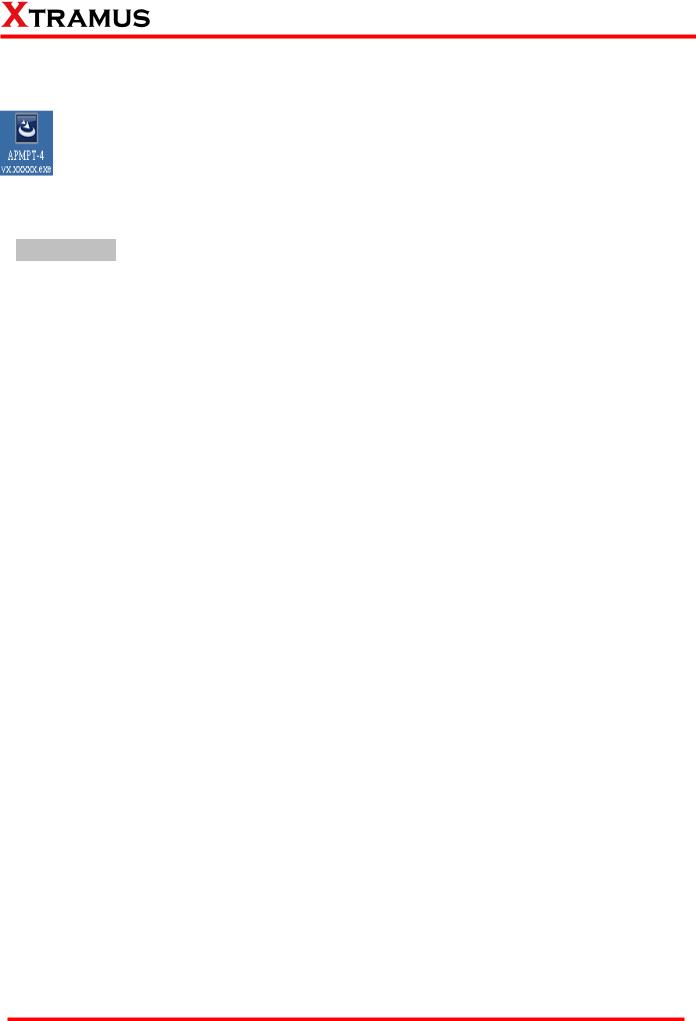
1. APMPT-4 Overview
1.1. General Description of APMPT-4
APMPT-4 is a utility-software for Microsoft Windows operating system. Specifically designed for Xtramus NuStreams chassis, APMPT-4 can perform tests in mass-production scale with pre-defined variable, and provide accurate, real-time DUT (Device under Test) status test reports.
1.2. Specifications & System Requirements
Specifications
|
Item |
|
|
Description |
|
|
|
||
|
Platform |
NuStreams-2000(i), NuStreams-600(i) chassis |
||
|
Operating System |
Microsoft Windows Vista /7/8, Microsoft Windows XP |
||
Supported Modules |
Xtramus XM-RM series Rapid-Matrix modules |
|||
|
|
|
|
|
|
|
|
Performance Task in Layer 1 (Layer1) |
|
|
|
|
Performance Task in Layer 2 (Layer 2) |
|
|
|
|
Performance Task in Layer 3 (Layer 3) |
|
|
Built-in Tasks |
|
PoE (Power over Ethernet) Tasks |
|
|
|
|
AC Tasks |
|
|
|
|
||
|
|
|
|
Terminal Tasks |
|
|
|
|
General Tasks |
|
|
|
|
Customization Tasks |
|
Multi-User |
Support Client-Server architecture for different users |
||
|
Report |
Test report in text format or real-time display |
||
|
Configuration |
Graphic User Interface (GUI) windows |
||
|
|
|
||
|
System Requirements |
|
|
|
OS |
|
Windows XP |
|
|
Windows Vista /7/8 |
|
|
|
|
|
|||
CPU |
|
|
Pentium 1.3 GHz or higher |
|
||
RAM |
|
512MB RAM |
|
|
1GB RAM |
|
HDD |
|
|
10GB available space |
|
||
XTRAMUS TECHNOLOGIES® |
6 |
E-mail: sales@xtramus.com |
|
|
Website: www.Xtramus.com |

1.3. Function Description
Built-in tasks in APMPT-4 include Unicast, Flow Control, Broadcast, Filter, CRC Error, Ping, PoE, Power, Console port tasks and other tasks.
1.3.1. Performance Task in Layer 1 (PT1)
DUT OSC Test
Test the speed rate of the DUT
By using this utility, operator is able to measure oscillator's speed of DUT that is either faster or slower than standard speed in ppm scale, or use it as criteria to judge the result of test.
1.3.2. Performance Task in Layer 2 (PT2)
A. Unicast Test
Unicast transmission is to send information packets to a single destination. In layer 2 test, unique MAC address is the key of single destination as illustration below.
Perform unicast test on DUT in layer2 with different speeds, modes and various configurations.
PT2-UC-10H (10Mbps Half Duplex),
PT2-UC-10F (10Mbps Full Duplex),
PT2-UC-100H (100Mbps Half Duplex),
PT2-UC-100F (10Mbps Full Duplex),
PT2-UC-1G (1Gbps Full Duplex),
PT2-UC-10G (10G Full Duplex),
PT2-UC-GROUPS (Perform Layer 2 MAC address Unicast performance test by two groups settings with different media types such as 100Mbps and 1Gbps for DUT ports with different maximum speeds)
XTRAMUS TECHNOLOGIES® |
7 |
E-mail: sales@xtramus.com |
|
|
Website: www.Xtramus.com |

B. Flow Control Test
Perform flow control test on DUT in layer 2 with different speeds, modes and various configurations. It tests the performance when the DUT is connected to the media type with varied kinds of speeds and directions.
PT2-FC-10H-100H (10Mbps Half ↔ 100Mbps Half),
PT2-FC-100H-10H (100Mbps Half ↔10Mbps Half),
PT2-FC-10F-100F (10Mbps Full ↔ 100Mbps Full),
PT2-FC-100F-10F (100Mbps Full ↔ 10Mbps Full),
PT2-FC-100F-1G (100Mbps Full ↔ 1Gbps Full),
PT2-FC-1G-100F (1Gbps Full ↔ 100Mbps Full),
PT2-FC-1G-10G (1Gbps Full ↔ 10G Full),
PT2-FC-10G-1G (10G Full ↔ 1Gbps Full),
PT2-FC-GROUPS (Perform Layer 2 Flow Control tests by two groups with different media types such as 100Mbps and 1Gbps for DUT ports with different maximum speeds.)
C.Broadcast Test
Broadcasting refers to transmitting packets that will be received (conceptually) by every device on the network.
Perform broadcast test on DUT in layer2 with different speeds, modes and various configurations. These following tasks transmit broadcast frames (Destination Address: FF:FF:FF:FF:FF:FF).
PT2-BC-10H, (10Mbps, Half Duplex)
PT2-BC-10F, (10Mbps, Full Duplex)
PT2-BC-100H, (100Mbps, Half Duplex)
PT2-BC-100F, (100Mbps, Full Duplex)
PT2-BC-1G, (1Gbps, Full Duplex)
PT2-BC-10G, (10Gbps, Full Duplex)
PT2-BC-GROUPS (Perform Layer 2 Broadcast test by two groups with different media types such as 100Mbps and 1Gbps for DUT ports with different maximum speeds.)
XTRAMUS TECHNOLOGIES® |
8 |
E-mail: sales@xtramus.com |
|
|
Website: www.Xtramus.com |
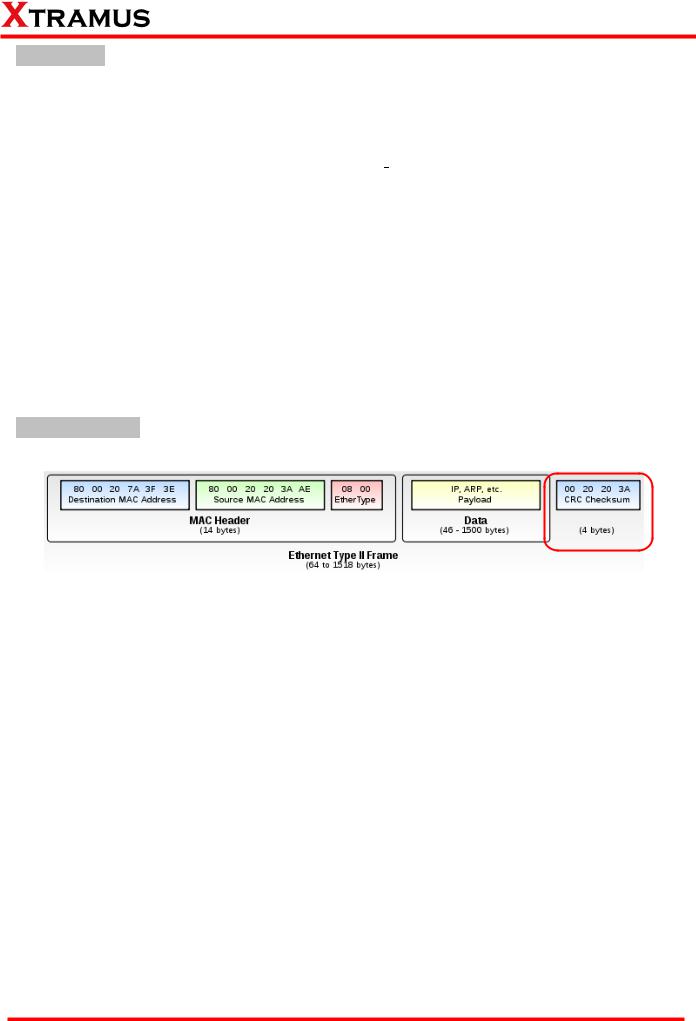
D. Filter Test
This filter test should filter all packets with the same source MAC address and destination MAC Address. For the test packets transmitted are all with the same source MAC address and destination MAC address and the DUT should filter this kind of packet.
Perform filter test on DUT in layer2 with different speeds, modes and various configurations. The following tasks transmit frames with same DA (destination address) and SA (source address).
PT2-FT-10H, (10Mbps, Half Duplex)
PT2-FT-10F, (10Mbps, Full Duplex)
PT2-FT-100H, (100Mbps, Half Duplex)
PT2-FT-100F, (100Mbps, Full Duplex)
PT2-FT-1G, (1Gbps, Full Duplex)
PT2-FT-10G, (10Gbps, Full Duplex)
PT2-FT_GROUPS (Perform Layer 2 Filter Test by two groups with different media types such as 100Mbps and 1Gbps for DUT ports with different maximum speeds.)
E.CRC Error Test
CRC Checksum is registered at the end of Ethernet frame.
Perform CRC (Cyclic Redundancy Check) error test on DUT in layer2 with different speeds, modes and various configurations for the last 4 bytes of CRC to be filtered. For normal DUT, frame with error CRC should be filtered. The following tasks transmit frames with CRC errors.
PT2-CRC-10H, (10Mbps, Half Duplex)
PT2-CRC-10F, (10Mbps, Full Duplex)
PT2-CRC-100H, (100Mbps, Half Duplex)
PT2-CRC-100F, (100Mbps, Full Duplex)
PT2-CRC-1G, (1Gbps, Full Duplex)
PT2-CRC-10G, (10Gbps, Full Duplex)
PT2-CRC-GROUPS (Perform Layer 2 CRC check test by two groups with different media types such as 100Mbps and 1Gbps for DUT ports with different maximum speeds.)
XTRAMUS TECHNOLOGIES® |
9 |
E-mail: sales@xtramus.com |
|
|
Website: www.Xtramus.com |

1.3.3. Performance Tasks in Layer 3 (PT3)
A. Network Tool: Ping
Ping is a network tool used to test whether a particular host is reachable across an IP network. It is also used to self-test the network interface card of the computer, or as a speed test.
Perform Ping test on DUT in layer3 that is based on different IP addresses, subnet mask, ping IP address and gateway.
PT3-Ping
B. Unicast Test
Unicast transmission is to send information packets to a single destination. In layer 3 test, unique IP address is the key of single destination as illustration below.
Perform unicast test on DUT in layer 3 with different speeds, mode and various configurations.
PT3-UC-10H, (10Mbps, Half Duplex)
PT3-UC-10F, (10Mbps, Full Duplex)
PT3-UC-100H, (100Mbps, Half Duplex)
PT3-UC-100F, (100Mbps, Full Duplex)
PT3-UC-1G, (1Gbps, Full Duplex)
PT3-UC-10G, (10Gbps, Full Duplex)
PT3-UC-GROUPS (Layer 3 Unicast Full Performance Test. Perform Layer 3 IP Address Unicast test by two groups with different media types such as 100Mbps and 1Gbps for DUT ports with different maximum speeds.)
XTRAMUS TECHNOLOGIES® |
10 |
E-mail: sales@xtramus.com |
|
|
Website: www.Xtramus.com |

1.3.4. PoE (Power over Ethernet) Test
Overview of PoE
PoE: Power Over Ethernet
Based on IEEE 802.3af and ongoing 802.3at
Protocol for DTE power via copper-based media
DTE (Data Terminal Equipment)
PSE: Power Sourcing Equipment
Equipment provides the power to PD by network cable.
PD: Powered Device
Device consumes the power from PSE by network cable. NuStream-2000i, 600i with PoE module acts as PD for the test.
A.PoE-Connect
Perform connect test on DUT (i.e. PSE) based on different configurations.
B. PoE-Disconnect
Perform disconnect test on DUT (i.e. PSE) based on different configurations.
C. PoE-Overload
Perform overload test on DUT (i.e. PSE) based on different configurations.
D. PoE-ShortCircuit
Perform short circuit test on DUT (i.e. PSE) based on different configurations.
E. PoE-Loading
Perform loading and transmitting packets test on DUT (i.e. PSE) based on different configurations.
F. PoE-Loading-GROUPS
Perform loading and transmitting packets test on DUT (i.e. PSE) based on different configurations and criteria for two groups with different media types such as 100Mbps and 1Gbps
G. POE-Dynamic Loading
Perform multiple loading and transmitting packets test on DUT (i.e. PSE) in different configurations at the same time.
XTRAMUS TECHNOLOGIES® |
11 |
E-mail: sales@xtramus.com |
|
|
Website: www.Xtramus.com |
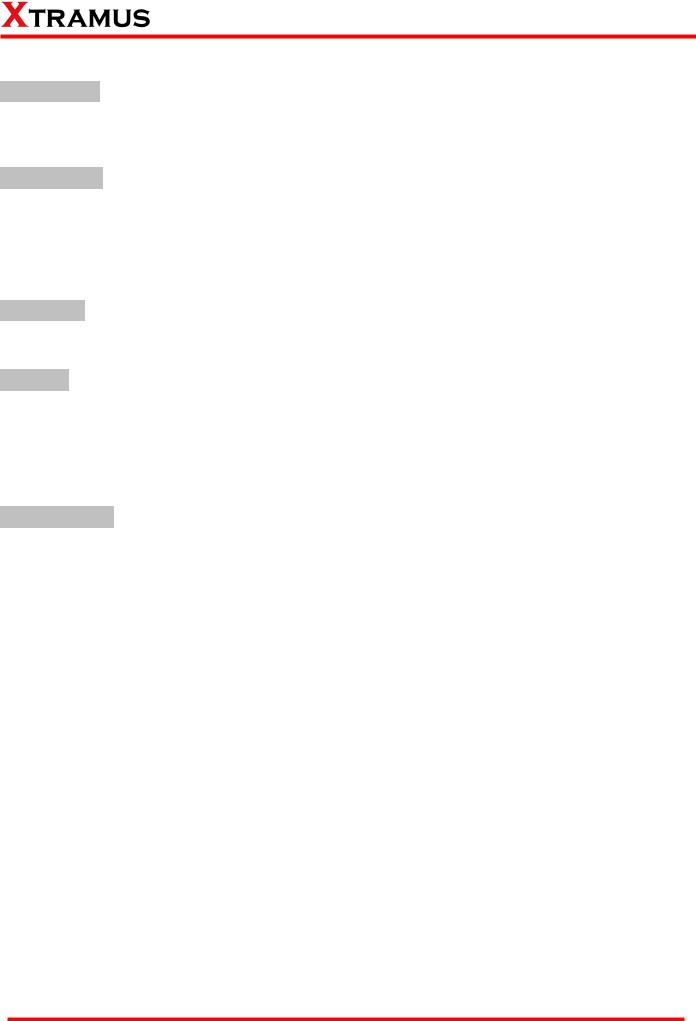
1.3.5. AC Test
A. PWR-Setup
Perform power control on DUT such as power ON control and cycle reboot through test module XM-2WL1. Under the control of XM-2WL1 module on chassis, the DUT that use the power from XM-2WL1 can have ON / OFF and reboot control.
B. PWR-Check
Perform power monitor and statistics measurement from power plug into test module XM-2WL1. The outlet of XM-2WL1 also supply power to DUT, thus operator gets the power statistics measurement to DUT.
1.3.6. Terminal Test
This test includes two parts: Console and Telnet test. Perform test by executing commands by manual script or script file to RS232 interface or Telnet Server of DUT.
A. Console
Console refers to the console port, COM port or RS232 interface. This test will perform a series of standard terminal command to check the response of COM port.
B. Telnet
Perform test by executing commands by manual script file to Telnet Server of DUT.
1.3.7. General Test
Tests listed in this category include: 1 to Many-UC, 1 to Many-MCV,CALL-EXT, Inserting Waiting Time,
Media Pre-setting ,Toggle MDI-II/X and Line Emulate .
A. 1 to Many-UC
1 to Many-UC is a Unicast Full Performance Test. Performing Layer 2 MAC address Unicast performance tests from one source to multiple ports with different media types (such as 100Mbps and 1Gbps Full).
XTRAMUS TECHNOLOGIES® |
12 |
E-mail: sales@xtramus.com |
|
|
Website: www.Xtramus.com |

B. 1 to Many-MCV
Performing Layer 2 VLAN address multicast performance tests from one source port to multiple destination ports with different media types (such as 100Mbps and 1Gbps Full).
C. CALL-EXT
This function allows you to execute your own programs/files as APMPT-4 Tasks.
D. Inserting Waiting Time
This function allows users to insert waiting time in-between tasks or to pause the whole testing process after completing a task.
E. Media Pre-Setting
Test MDIX by Media Pre-setting mode or force MDI (straight-through connection) or MDIX (crossover connection) mode of DUT.
F.Toggle MDI-II/X
Test the Auto MDIX function of different speeds/link modes of the DUT. Toggle MDI-II/X is a technology that automatically detects the required cable connection type (straight-through or crossover) and configures the connection appropriately.
G. Line Emulate
This function allows you to set the device 5160 or other line simulators connecting to the DUT port. Line Emulate task must be performed ahead of the task which needs it.
1.3.8. Customization Test
A. CTM-BSTAR-001
This function allows two ports to co-transmit packets in which both side can have different Tx parameters.
XTRAMUS TECHNOLOGIES® |
13 |
E-mail: sales@xtramus.com |
|
|
Website: www.Xtramus.com |

2.Software/Hardware Installation for APMPT-4
2.1.Install/Uninstall APMPT-4 on PC
Please follow the steps down below to install APMPT-4:
1. Double-click APMPT-4 installation program and start the installation process.
2. InstallShield Wizard is starting to install APMPT-4. If you would like to cancel installation, click Cancel.
3. Click Next to continue installation.
4. Click I accept the terms in the license agreement, and click Next to continue.
XTRAMUS TECHNOLOGIES® |
14 |
E-mail: sales@xtramus.com |
|
|
Website: www.Xtramus.com |

5. Input the User Name and Organization and click Next to continue.
6. Click the Change… button to install the program to another folder, or click Next button to install the program into the default destination folder, and then continue next step. Click Back button to go back to the previous step to modify.
7. Click Install to begin the installation.
8. InstallShield Wizard is installing APMPT-4.
XTRAMUS TECHNOLOGIES® |
15 |
E-mail: sales@xtramus.com |
|
|
Website: www.Xtramus.com |
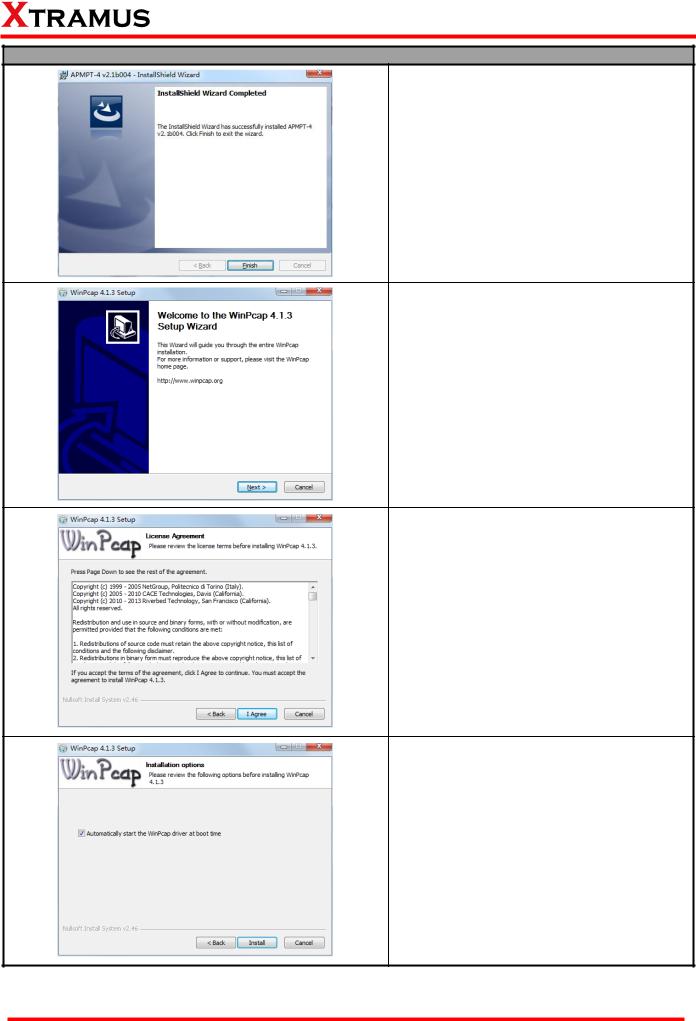
9. Click Finish to exit the wizard.
10. WinPcap Installer appears. Click Next button to get ready to install, or click Cancel button to stop.
11. Review the license agreement before installing. Click I Agree button to continue. It is necessary to accept the agreement to install WinPcap.
12. It is high recommended to check the
“Automatically start the Wincap driver at boot time” as default. Then click Install.
XTRAMUS TECHNOLOGIES® |
16 |
E-mail: sales@xtramus.com |
|
|
Website: www.Xtramus.com |
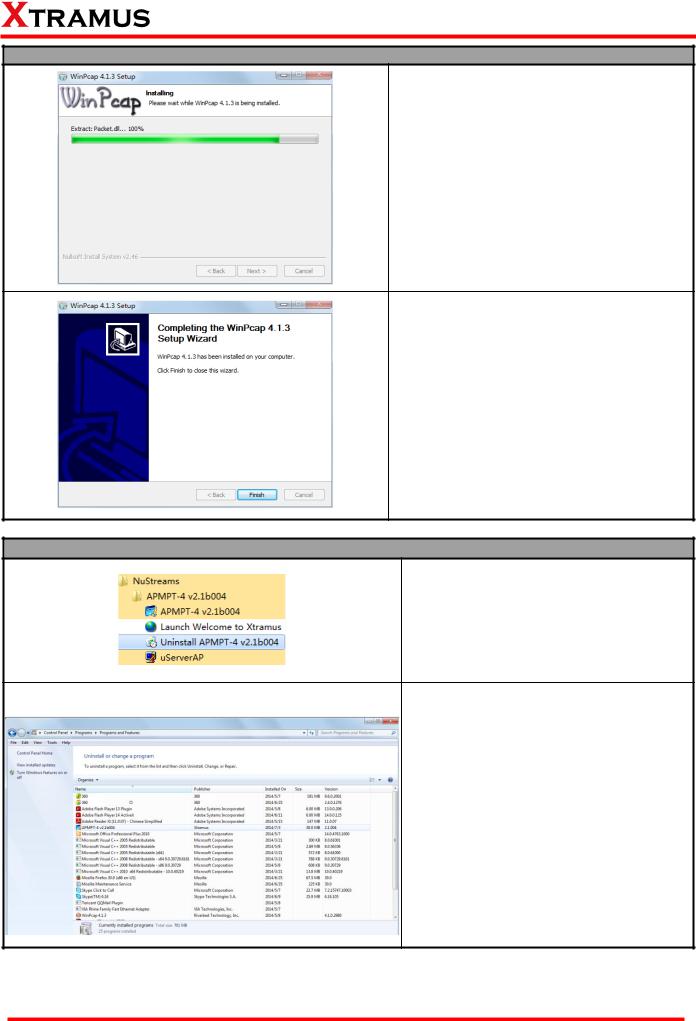
13. WinPcap is installing.
14. WinPcap installation completes. Click Finish button to close the wizard.
You can uninstall APMPT-4 by:
Click Start → Programs → NuStreams →
APMPT-4→ Uninstall APMPT-4
Go to the Control Panel, choose APMPT-4 from installed program list, and click “Uninstall”.
XTRAMUS TECHNOLOGIES® |
17 |
E-mail: sales@xtramus.com |
|
|
Website: www.Xtramus.com |

2.2. Hardware Installation
Before running APMPT-4 after installation, please be sure that you‟ve installed both the DUT and your PC with Nustreams-2000i/600i properly as shown in the illustrations down below.
For operating APMPT-4 on NuStreams-2000i and NuStreams-600i Chassis, an external PC is required. For NuStreams-2000i, connect network port of PC LAN card to DOWN (or UP) port of XM-2S19 with network cable.
For NuStreams-600i, connect network port of PC LAN card to DOWN (or UP) port of XM-2S10 with network cable.
Please note that the PC‟s TCP/IP setting should be configured so that the PC‟s NIC will obtain an IP address from NuStreams-2000i/600i automatically.
XTRAMUS TECHNOLOGIES® |
18 |
E-mail: sales@xtramus.com |
|
|
Website: www.Xtramus.com |
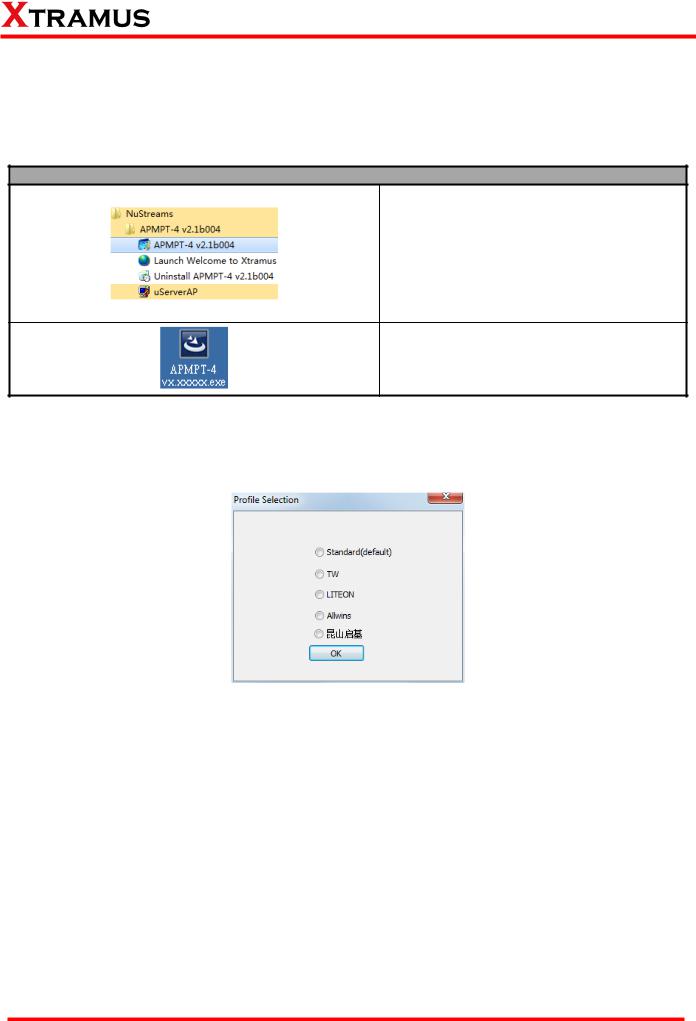
3.APMPT-4 Overview
3.1.Starting APMPT-4
Before starting APMPT-4, the DUT, your PC, and NuStreams-2000i/600i shall be connected as shown in
“2.2. Hardware Installation”.
You can start running APMPT-4 by:
Click Start Programs NuStreams
APMPT-4.
Double-click APMPT-4 icon located on your
PC‟s desktop.
When you first start the APMPT-4, a Profile Section window as below will pop up. Select standard (default) option in general case. If you are a user of a certain customized company, select the corresponding option.
If your PC is not connected with NuStreams-2000i/600i, you can still run APMPT-4 under Demo Mode. Almost all APMPT-4‟s functions are available under Demo Mode. However, please note that Demo Mode is for system demo purposes only, and does not serve any test purpose at all.
XTRAMUS TECHNOLOGIES® |
19 |
E-mail: sales@xtramus.com |
|
|
Website: www.Xtramus.com |

XTRAMUS TECHNOLOGIES® |
20 |
E-mail: sales@xtramus.com |
|
|
Website: www.Xtramus.com |
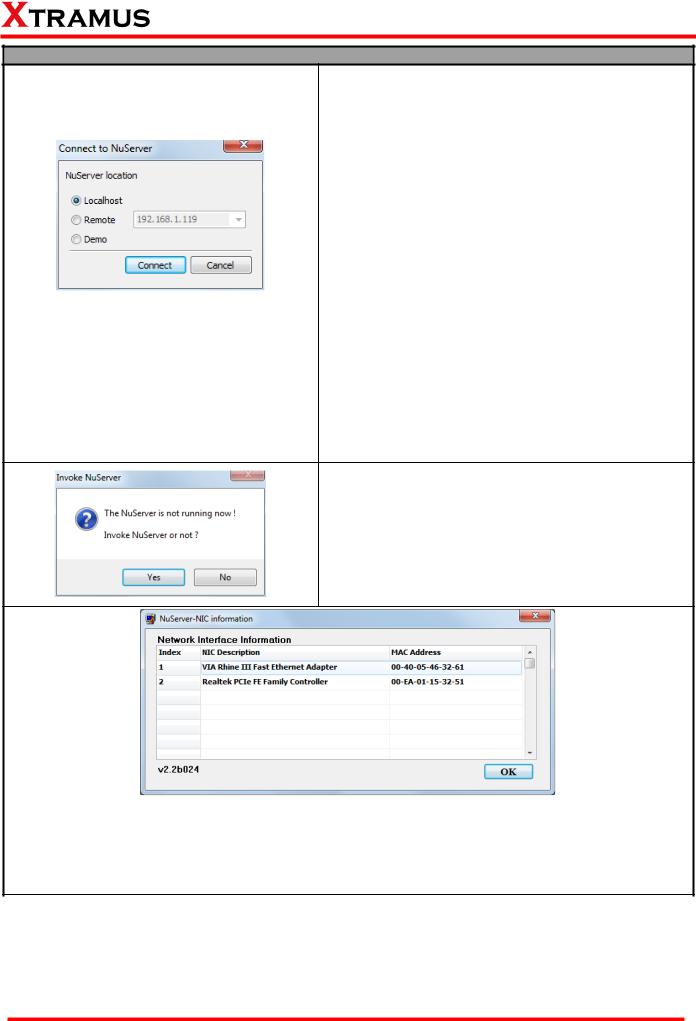
Please follow the steps down below to start APMPT-4:
When starting APMPT-4, a “Connect to NuServer” window will pop up and asked how you are going to connect to NuServer.
Local Host: Choose this option when you‟re running APMPT-4 from NuStreams-2000i IPC module or a PC that‟s connected to
NuStreams-2000i/600i via an RJ45 cable.
Remote: Choose this option when you‟re running
APMPT-4 from other PC located on the network. Choose the IP address which is assigned from NuStreams-2000i/600i from the scroll-down menu
Demo: Choose demo to enter APMPT-4‟s Demo Mode.
Connect/Cancel: Click the Connect button to connect to NuStreams-2000i/600i or click the Cancel button to quit.
If NuServer is not running while starting APMPT-4, a window will pop up and ask if you would like to run NuServer. Please click Yes to continue or No to cancel.
A “NuServer-NIC Information” window will pop up. Please select the NIC (Network Interface Card) which is connected to NuStreams -2000i/ 600i from the Network Interface Information table, and click OK. If you‟re using NuStreams-2000i‟s IPC module, please choose “Realtek RTL8139 Family Fast Ethernet”. NuServer will connect to the daughter boards, and APMPT-4 will start as well.
XTRAMUS TECHNOLOGIES® |
21 |
E-mail: sales@xtramus.com |
|
|
Website: www.Xtramus.com |
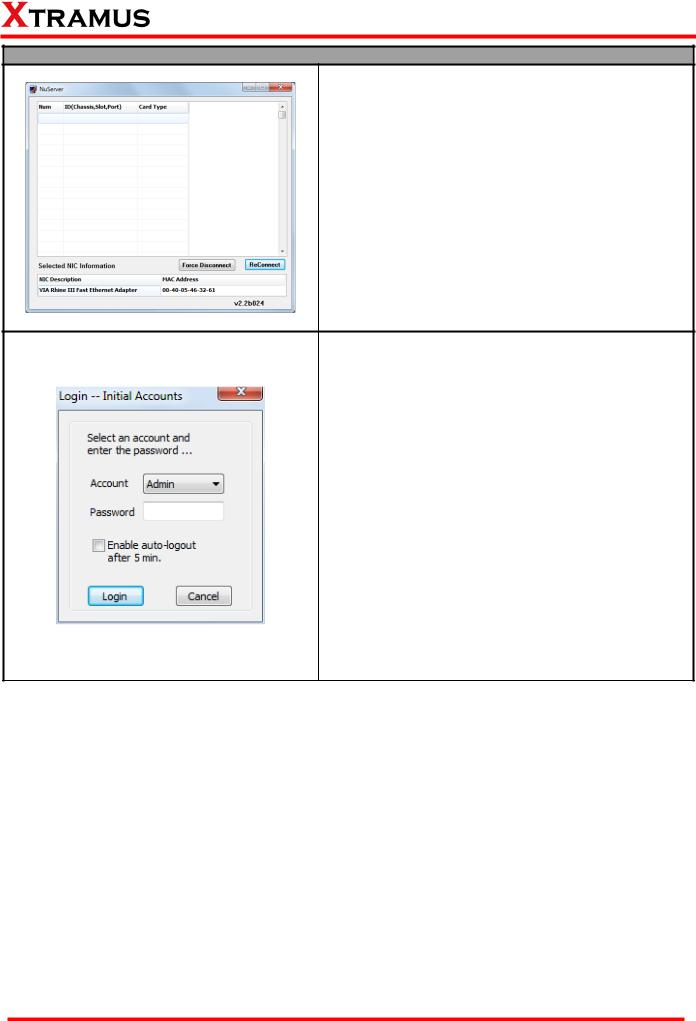
Please follow the steps down below to start APMPT-4:
When the information listed in the Nuserver window is abnormal, click Force Disconnect, and then click
ReConnect.
Force Disconnect: Disconnect with NuStreams -2000i/ 600i forcefully.
ReConnect: Reconect with NuStreams -2000i/ 600i.
For security reasons, APMPT-4 requires
Account/Password to login. The default
Account/Password is:
Account: Admin
Password: xtramustech
Please note that the password is case-sensitive, and shall be changed as soon as you login for the first time.
Please refer to “3.3.4. Security” for more information about how to change APMPT-4‟s password.
Enable auto-logout after 5 min: Enable this function so APMPT-4 shall automatically logout after 5 minutes.
Login/Cancel: Click Login/Cancel button to login or cancel.
XTRAMUS TECHNOLOGIES® |
22 |
E-mail: sales@xtramus.com |
|
|
Website: www.Xtramus.com |
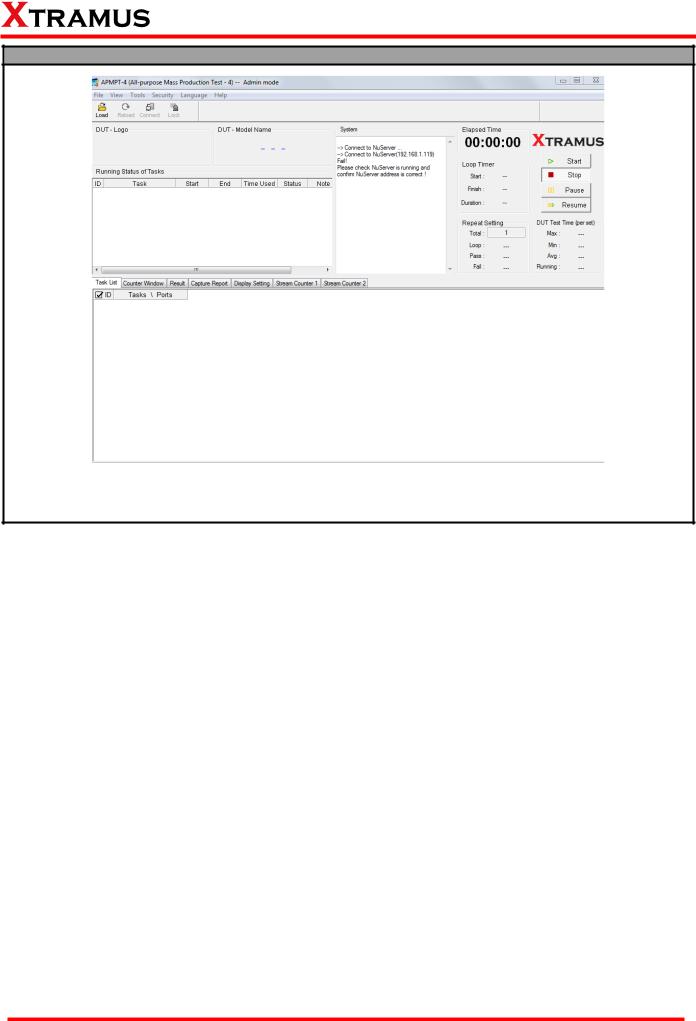
Please follow the steps down below to start APMPT-4:
You now have access to APMPT-4‟s main display window.
XTRAMUS TECHNOLOGIES® |
23 |
E-mail: sales@xtramus.com |
|
|
Website: www.Xtramus.com |

3.2. APMPT-4/NuServer Main Window Overview
APMPT-4 Main Window
Function Descriptions
|
The Menu Bar allows you to manage test model settings, view test log/ |
|
Menu Bar |
model information, set/reset APMPT-4 password, and change language |
|
|
displayed. |
|
|
|
|
Quick Launch Buttons |
The Quick Launch Buttons allow you to load/reload test model settings, |
|
connect to the NuServer, and lock test model. |
||
|
||
|
|
|
DUT Information |
This section of the main window contains the DUT„s logo and model |
|
name. |
||
|
||
|
|
|
Task Running Status |
This section of the main window contains general information/status of the |
|
tasks that are currently running. |
||
|
||
|
|
|
Status Bar |
The Status Bar shows the APMPT-4‟s running status. |
|
|
|
|
System Status |
The System Status displays running processes of APMPT-4 system. |
|
|
|
|
Test Control & Status |
The Test Control & Status section contains test control buttons (which |
|
allow you to Start/Stop/Pause/Resume tests) and general test information. |
||
|
||
|
|
|
Test Result/Report |
This section allows you to view the test results. |
|
|
|
XTRAMUS TECHNOLOGIES® |
24 |
E-mail: sales@xtramus.com |
|
|
Website: www.Xtramus.com |
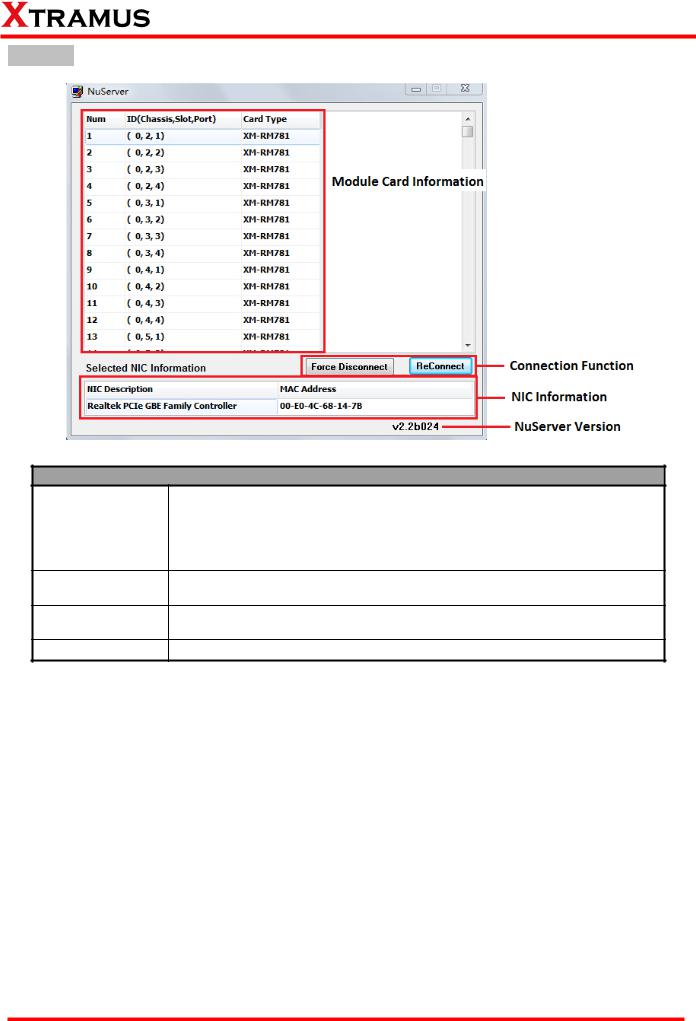
NuServer
Description
|
This section displays the information regarding to the model cards that are |
|
Module Card |
installed on NuStreams-2000i/600i. Model Card IDs are showed as the |
|
format of (X, Y, Z) while X is the number of the chassis (which is displayed |
||
Information |
||
on NuStreams-2000i/600i), Y is the slot number where this model card is |
||
|
||
|
installed, and Z is the available port number located on the model card. |
Connection You can reconnect a link down status or force to disconnect your Function NuStreams-600i/2000i to your PC.
NIC Information This section displays the detail information (including NIC Model name,
NIC‟s MAC address) regarding to the selected NIC.
NuServer Version This section displays the version of your NuServer.
XTRAMUS TECHNOLOGIES® |
25 |
E-mail: sales@xtramus.com |
|
|
Website: www.Xtramus.com |

3.3. Menu Bar
APMPT-4 Menu Bar includes configuration options such as File, View, Tools, Security, Language, and Help. Please refer to the sections down below for detail information regarding to each configuration option.
3.3.1. File

 File Menu Bar Overview
File Menu Bar Overview
Choose this option to start the New Model Wizard. The New Model Wizard allows
New Model Wizard the users to set testing options for DUT. For detail descriptions regarding to the New Model Wizard and its settings, please refer to”4. Creating Task via New
Model Wizard”.
|
|
|
Load a previously-saved configuration file and |
|
|
|
apply these settings to APMPT-4. |
|
|
|
All the configurations you‟ve made via New |
Load Model |
|
|
Model Wizard will be saved as a “*.xml” file, |
|
|
along with several “*.cfg” files. |
|
|
|
|
|
|
|
|
Please note that these “*.cfg” files contain test |
|
|
|
settings as well. Deleting them will cause your |
|
|
|
“*.xml” file unable to load properly. |
|
|
|
|
|
Choose this option to make changes to the current test settings for DUT. For detail |
||
Modify Model |
descriptions regarding to these settings, please refer to the section down below. |
||
|
|
|
|
|
|
A prompt pop-up window will ask if you are sure to |
|
Exit |
|
exit APMPT-4. Click Yes to exit APMPT-4, or click |
|
|
|
No to cancel. |
|
|
|
|
|
XTRAMUS TECHNOLOGIES® |
26 |
E-mail: sales@xtramus.com |
|
|
Website: www.Xtramus.com |

3.3.2. View
View
Latest Log Choose Latest Log allows you to view the latest test log file (in “*.txt” format). |
|
|
|
Log Folder |
Choose Log Folder, and then the folder where all the saved test logs of the current test |
|
model will be opened. |
Choose Model Folder, and then the folder where all the DUT model configuration files are Model Folder saved will be opened. The default Log folder file path is under “C:\Program
Files\NuStreams\APMPT-4 v2.1b004\config”.
Module |
|
|
Information |
|
|
|
The Module Information window displays all the module cards that are installed on |
|
|
NuStreams-2000i/600i and their detail information. To close the Module Information |
|
|
window, click OK button. |
|
NuServer |
Display the NuServer window. For more information regarding to NuServer window, |
|
please refer to “3.2. APMPT-4/NuServer Main Window Overview”. |
||
|
||
|
||
Simple Style Choose Simple Style will make you run the tests under a simple mode. |
||
XTRAMUS TECHNOLOGIES® |
27 |
E-mail: sales@xtramus.com |
|
|
Website: www.Xtramus.com |
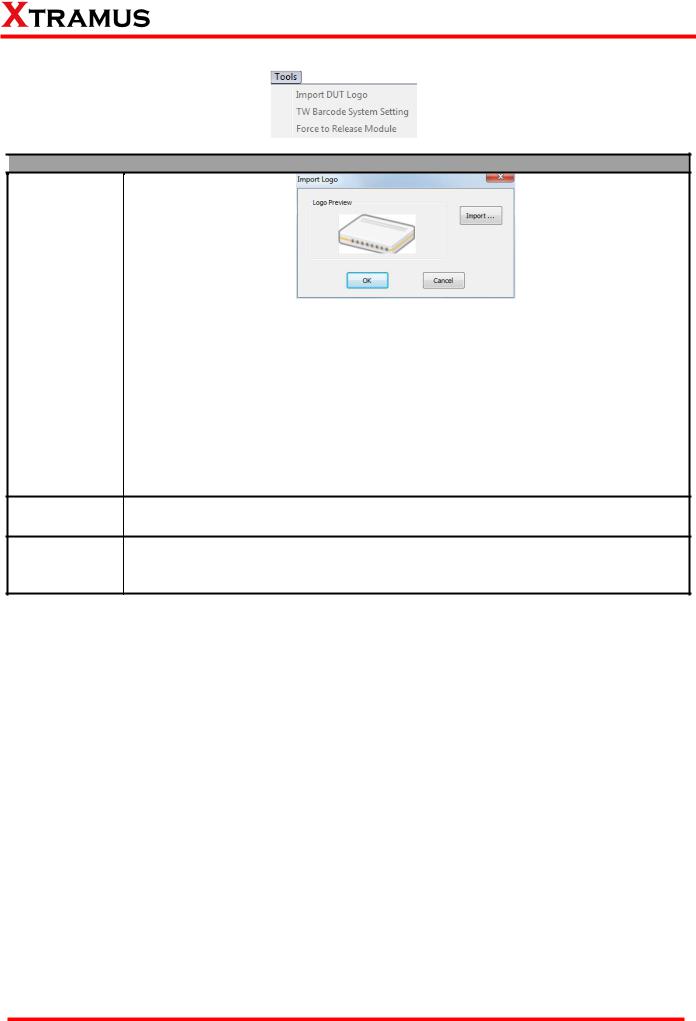
3.3.3. Tools

 Tools
Tools
Import DUT |
You can load an image file that represents the DUT for testing via Import DUT Logo |
|
function. The image file you chose will be shown on DUT Logo field of the Main |
||
Logo |
||
Window. |
||
|
||
|
Logo Preview: The image you‟ve chosen will be displayed in this field for |
|
|
preview. |
|
|
Import: Click this button to choose the image file that will be displayed. |
|
|
OK: Click this button to apply the changes you‟ve made. |
|
|
Cancel: Click this button to abandon all the changes you‟ve made and exit |
|
|
Import Logo Window. |
TW Barcode The Setting is for TW Barcode System
System Setting
When the test encounters some unexpected problems which lead the board dead, or Force to other tests need to lock the current board, you can choose Force to Release Module
Release Module to obtain the board again.
XTRAMUS TECHNOLOGIES® |
28 |
E-mail: sales@xtramus.com |
|
|
Website: www.Xtramus.com |
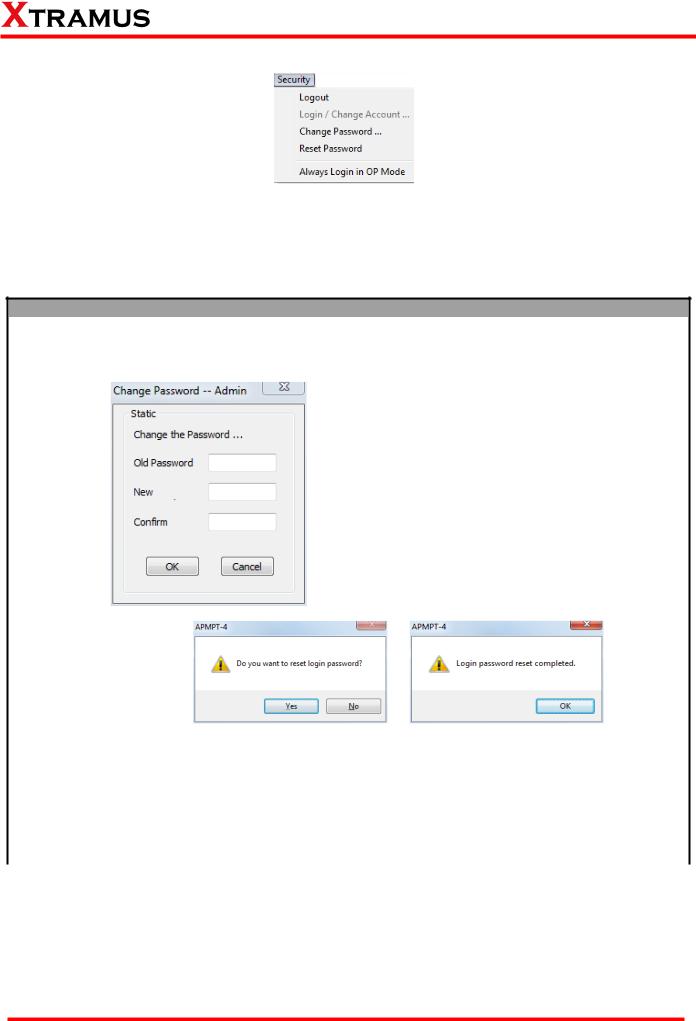
3.3.4. Security
APMPT-4 can run under Admin Mode and Operator Mode:
Admin Mode: Users have the maximum authorization and can access all APMPT-4‟s functions.
Operator Mode: Users are only allowed to access APMPT-4‟s basic functions such as loading saved DUT model test settings and view latest test log/module card information/NuServer
Security
Logout |
Logout from Admin Mode and switch APMPT-4 to Operator Mode. |
|
|
Login/Change |
Login to the Admin Mode. |
Account |
|
|
You can change the password for Admin Mode here. |
|
For security reasons, it is recommended to change |
|
APMPT-4‟s password after you first login. |
|
Old Password: Enter the old password here. |
|
New: Enter the new password here. The new |
Change |
password should be 6~12 characters and |
Password |
mustn‟t contain special symbols. |
|
Confirm: Please type your new password again |
|
for confirming. |
|
OK: Apply all the changes you‟ve made and |
|
apply. |
|
Cancel: Cancel and abandon all the changes |
|
you‟ve made. |
Reset |
|
Password |
If you forget APMPT-4‟s Admin Mode password, you can reset the password to the |
|
|
|
default password “xtramustech”. |
|
Click Yes to start resetting the login password (or No to cancel), and click OK to |
|
complete. |
|
|
Always login |
Every time when APMPT-4 starts running, it will run under Operator Mode. |
in OP Mode |
XTRAMUS TECHNOLOGIES® |
29 |
E-mail: sales@xtramus.com |
|
|
Website: www.Xtramus.com |
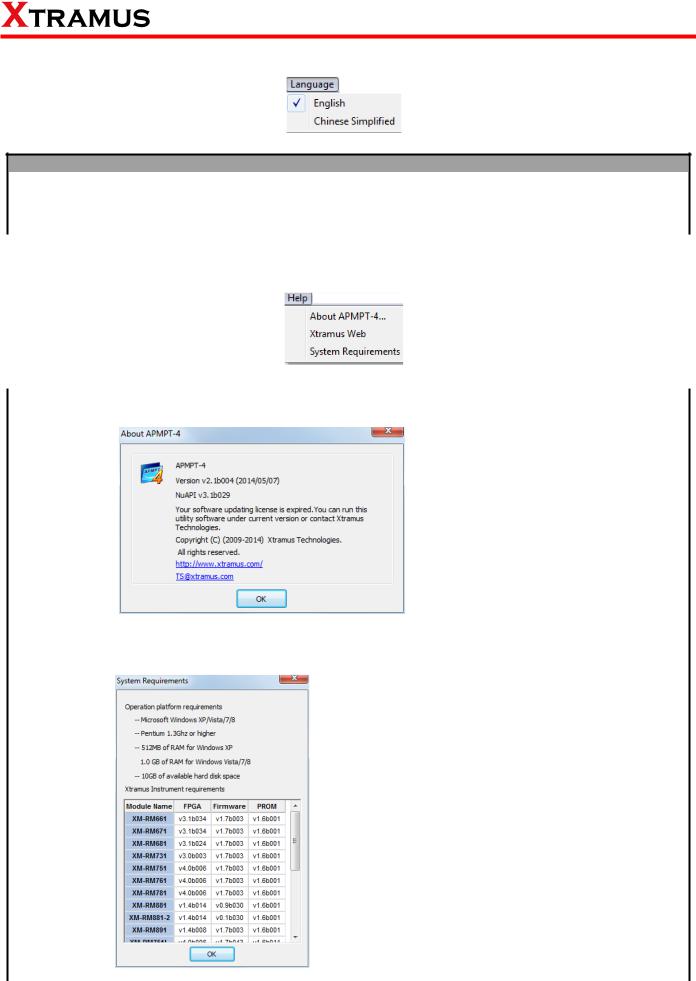
3.3.5. Language
Language
|
English/ |
APMPT-4 has 2 different languages for its UI available. You can set the language of UI to |
|
|
Chinese |
||
|
either English or Simplified Chinese. |
||
|
Simplified |
||
|
|
|
|
|
|
|
|
|
3.3.6. Help |
|
|
|
|
|
|
|
Help |
|
|
About |
|
|
The About APMPT-4 window will pop up |
|
APMPT-4 |
|
|
and show detailed system information. |
|
|
|
|||
Xtramus Web |
Click this option to access to Xtramus official website. |
|||
|
|
|
||
|
|
The “System Requirements” window will pop up and |
||
System |
|
show the requirements for your PC and the |
||
|
FPGA/Firmware/PROM version limit of the module |
|||
Requirement |
|
|||
|
cards. Click the Ok button to exit the “System |
|||
|
|
|||
|
|
Requirements” pop up window. |
||
|
|
|
|
|
|
|
|
|
|
XTRAMUS TECHNOLOGIES® |
30 |
E-mail: sales@xtramus.com |
||
|
|
|
Website: www.Xtramus.com |
|
